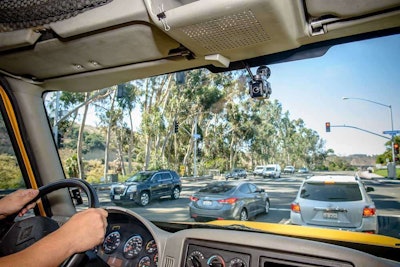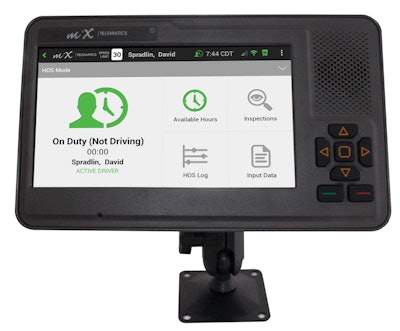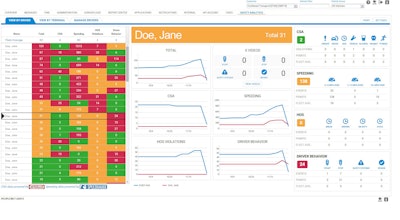 CTS uses custom training modules in the CarriersEdge platform to help drivers operate CNG-powered tractors.
CTS uses custom training modules in the CarriersEdge platform to help drivers operate CNG-powered tractors.Motor carriers are separating themselves from traditional approaches for training drivers. One-size-fits-all programs are on the way out, and are being replaced with technology that identifies the specific needs of drivers and delivers custom, digital training content within an automated, closed-loop process.
As part of this evolution, carriers are making training financially rewarding for their drivers. Besides raising the bar on safety, carriers are using training platforms to create incentives for drivers to improve their skills.
Advancements in driver safety systems are identifying more complex patterns of risk such as fatigue, distraction and rolling through stoplights. New developments also make it possible for fleets to train drivers without adding more hardware and alerts to the work environment.
Online training
Like many carriers, Premium Transportation Logistics (PTL) assigns training to newly hired drivers for orientation. The Toledo, Ohio-based nationwide ground transportation and logistics provider uses online training to improve fleet efficiency and the learning experience for drivers.
PTL uses the Drive First training collection and online learning management system (LMS) from Luma. The collection has more than 100 individual learning modules called eNuggets that cover a variety of safety, compliance and orientation topics.
The eNuggets can be customized to include company-specific policies and procedures.
“Drive First has made us more efficient in delivering training and documents to drivers, who mostly access the platform on their smartphones,” said Jeff Curry, president of PTL. “Drive First has been a big hit with our drivers.”
Luma offers Drive First as a monthly subscription based on a carrier’s estimated usage with no long-term contracts required.
Many of the drivers hired by Contract Transport Services (CTS) come straight from CDL schools. New drivers go through a three-week training program that is augmented by interactive, online courses from CarriersEdge. CTS also assigns online courses to drivers on a quarterly basis.
 GetGo Transportation is working with Netradyne and ITI to define the thresholds for driver behaviors to automatically assign training.
GetGo Transportation is working with Netradyne and ITI to define the thresholds for driver behaviors to automatically assign training.Using courses from CarriersEdge has replaced live meetings and is “so much more convenient for our drivers and our training staff,” says Paul LeRoy, director of safety for Green Bay, Wis.-based fleet.
“Drivers can go through the training modules when it’s convenient for them – at home, in their cab during a break, or at one of our terminals,” he says.
Drivers retain more information as well.
“That’s ultimately what we want,” he says. “We can monitor how our drivers have done on each module – if there is an area they didn’t score well on, we can review the test with them and help them with additional information.”
CTS has custom training modules in the CarriersEdge platform that help drivers operate CNG-powered tractors. Currently half of the fleet is CNG with plans to become 100 percent by the end of 2019. It also distributes a semi-annual “state of the union” address and other live training broadcasts through the platform.
GetGo Transportation, in Millbury, Ohio, has been using online Pro-TREAD driver training courses from Instructional Technologies, Inc. (ITI) for about two years.
Rob Wayne, the fleet’s director of safety and recruiting, assigns training to new hires during the orientation period and thereafter on an as-needed basis “when we see something happen,” he says. As an example, a driver that receives a maintenance violation from a DOT roadside inspection would have to complete a course on pre-trip inspections.
Driver coaching
The use of video-based safety and telematics systems has shifted the focus of training to the individual needs of drivers. CTS tractors are equipped with the Lytx DriveCam technology.
“Our coaching involves showing the driver the specific behavior that was captured on the DriveCam and how modifying their behavior can result in a safer and less stressful day,” LeRoy says.
When coaching drivers, the best approach is to get the driver to agree on what behavior needs to change, says Del Lisk. The DriveCam program tracks when the driver was first coached on that behavior and if the behavior repeated itself.
 SmartDrive has a Coaching Effectiveness Score fleets can use to assess the performance of coaching and training.
SmartDrive has a Coaching Effectiveness Score fleets can use to assess the performance of coaching and training.“It may be that coaching is not enough,” says Del Lisk, vice president of safety services at Lytx. “Generally, through use of our system, if despite coaching a driver is not changing behavior, training would be next step.”
For events that result in an incident or accident, CTS will assign a CarriersEdge training course to drivers to make sure they understand basic safety standards, LeRoy says.
Video-based safety and telematics systems identify driver needs by compiling behavior data into predictive scores for crash risk, and measure how drivers are responding to coaching and training events.
SmartDrive has a Coaching Effectiveness Score fleets can use to assess the performance of coaching and training. The score gives background detail for when a driver was last coached or completed training, explains Jason Palmer, chief operating officer of SmartDrive.
Similarly, if a group of drivers took a defensive driving training class, the SmartDrive program can offer insight into their performance after the training was completed, he adds.
Fleets that use Trimble’s Video Intelligence Solution can measure the effectiveness of driver coaching and training by tracking the number of miles between “trigger” events that include sudden start, sudden stop and activation of vehicle safety systems.
A carrier with 100 drivers, for example, may be averaging an event every 600 miles.
“Over time, they’re measuring the effectiveness of training and coaching in terms of increased miles between those events,” explains Jim Angel, vice president of Video Intelligence at Trimble Transportation Mobility, formerly PeopleNet.
MiX Telematics has an in-cab video system, MiX Vision, that captures video footage of risky driving behaviors. The company has a reporting feature, Insight Agility, that fleets can use to create customized reports and dashboards to compare driver behaviors before and after training events, says Adam Bruttell, vice president of North American sales.
Closing the loop
Systems that monitor and assesses driver risk can be integrated with LMS platforms to automatically assign training to drivers in a closed-loop process.
 MiX Telematics has a reporting feature, Insight Agility, that fleets can use to create customized reports and dashboards to assess driver behaviors and the effectiveness of training events.
MiX Telematics has a reporting feature, Insight Agility, that fleets can use to create customized reports and dashboards to assess driver behaviors and the effectiveness of training events.About one year ago, GetGo started to use a camera vision safety system from Netradyne called Driveri (“driver eye”). The technology detects and scores drivers on a wide range of safe and unsafe behaviors.
With the online LMS platform from ITI, called Sentix, training can be assigned to drivers based on individual behaviors identified by third-party systems, says Aaron Purvis, chief technology officer of ITI.
Currently, GetGo is working with Netradyne and ITI to define the thresholds for driver behaviors that will trigger the training assignments, Wayne says.
Purvis recommends that fleets coach drivers in person for critical events and assign training for non-critical behaviors that accumulate over a short period, such as a month. As an example, Sentix could automatically assign training to the 10 percent of drivers in a fleet that have the most speeding violations.
The Sentix LMS can track when drivers completed training and the results that follow. If a driver repeats the behavior, “we make sure we are adjusting the message,” Purvis explains.
EBE Technologies has an LMS that fleets can use to assign custom or third-party training content to drivers based on trigger events from their video and telematics safety systems such as hard braking, excessive idling or low mpg events.
For some events a fleet may assign a video with a quiz afterwards, while others may require a sit-down session with a fleet manager. Other options include sending drivers a link to website or any other type of media, explains Cindy Nelson, vice president of marketing and Driver Solutions Group for EBE.
Training incentives
Fleets that require drivers to complete training following a critical safety event may find that getting drivers to complete monthly or quarterly training courses may not be as easy to enforce.
CTS includes training in its performance pay program as one of six areas of concentration. Drivers have to complete their quarterly training assignments to get the maximum points and dollars.
 CTS, based in Green Bay, Wis., has specialty themed fire and police tractors.
CTS, based in Green Bay, Wis., has specialty themed fire and police tractors.“We place a lot of importance on training,” LeRoy says. Drivers that complete the assignments earn an extra $0.04 per mile, which is a significant portion of the total $0.06 per mile bonus available.
GetGo Transportation currently pays drivers a 3.5 cents-per-mile bonus on every paycheck for not having accidents or violations that count against the fleet’s Compliance, Safety, Accountability (CSA) score. Wayne is considering making training part of the bonus program.
If drivers do not complete assigned training by a certain date, they could lose the bonus, he says. GetGo’s base pay rate is 46.5 cents per mile. With the 3.5 cent bonus, drivers make $0.50 per mile and can earn an extra $0.03 per mile with a hazmat endorsement.
“It is in their best interest to complete the training to not lose any money,” he says. “We are promoting a safe culture.”
Wayne is also interested in an additional reward for safe driving. The fleet’s Netradyne system creates a composite score for drivers that includes both safe and unsafe behaviors.
“We have drivers coming in weekly, asking ‘what is my score this week?’” Wayne says. Drivers start with 1,000 points and lose points by unsafe behaviors. If drivers keep their scores above 850 for 90 days, they could earn an extra bonus starting in January, 2019, he says.
Combined approach
Advancements in driver safety systems can now detect complex patterns of risk such as fatigue, distraction and running through stoplights instantly. Adding more alerts to a driver’s work environment may not be the best way to positively change behaviors, however.
SmartDrive has analyzed visual and audio alerts from vehicles equipped with Advanced Driver Assistance Systems (ADAS) across 3 billion driving miles. It found 15 percent fewer collisions in vehicles equipped with a driver feedback mechanism.
While smart sensors are getting more and more capable of detecting indicators of dangerous driving — such as fatigue — “technology providers must remain vigilant in limiting the safety risk of the technology itself,” says SmartDrive’s Jason Palmer. “Smart sensors may present a safety issue if they provide the driver with too much feedback while driving.”
 Trimble Transportation Mobility’s Safety Analytics dashboard identifies the most risky drivers in a fleet.
Trimble Transportation Mobility’s Safety Analytics dashboard identifies the most risky drivers in a fleet.ITI’s Aaron Purvis sees a future where training content becomes integrated with advanced sensors in the vehicle. If a driver runs through a stop sign, for instance, an instant notification could be sent to an in-cab telematics system that says, “You need to pull to the side.”
Rather than have a driver take a training course, ITI could do a quick, 30-second voice training to explain the risks of that specific behavior, he says.
Trimble’s Jim Angel does not see a need to add more sensors to the cab. With the integration of Pulsar’s Trucking Fatigue Meter technology, Trimble’s Safety Analytics dashboard uses a driver’s hours-of-service and Onboard Event Recorder data to detect fatigue.
If the driver is approaching a yellow or red fatigue score, “we validate it by looking at OER data that indicates fatigue such as risk-based driving events like sudden stops,” Angel says.
Results from fleets that use the SmartDrive program show that face-to-face coaching and training are incrementally more effective than in-cab feedback alone at improving driving skills, Palmer says. This is particularly true for complex behaviors tightly linked to collisions such as unsafe turning, running stop signs and U-turns.
“The best approach is to incorporate multiple tactics to improve safety,” he says.













